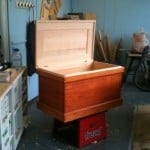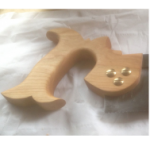bubinga low table
Welcome! / Forums / General Woodworking Discussions / Projects / bubinga low table
- This topic has 9 replies, 4 voices, and was last updated 10 years, 9 months ago by
 Mark Armstrong.
Mark Armstrong.
-
AuthorPosts
-

I’m trying a few new things for my latest piece- a low sideboard framed in bubinga pommele veneer- so I thought I would write a few posts on my progress.
It’s a really ambitious piece, over 6 feet long with metal legs. All the surfaces inside and out will be veneered with bubinga, and I am trying to use a single sheet for the sides and top, with the grain continuously flowing over the sides. To support the weight of the 1″ ply across it’s 6′ length, I am going to add some polished metal supports in the middle. If I can pull it off, the result should be a contemporary-looking table, and hopefully quite appealing.
I was worried about the plywood showing through the edges of the veneer as the corners will be mitred, so I framed all the panels in 1″ solid cherry. Now if the veneer should become thin at the edges, there is solid wood of a similar colour underneath it.
Today I started the veneering. The first piece did not go well at all! Either I did not use enough glue or the caul did not provide sufficient pressure in places and the veneer did not adhere to the plywood substrate at the edges. Fortunately the centre of the panel was glued up successfully. Using a syringe, I applied glue between the veneer and plywood where the adhesion was poor and clamped everything together with lots of glue and wax paper to catch the drips. That’s every clamp I own! I wish I had more. Photo 1.
I am not taking any chances with the other panels. The two sides are in the bag with plenty of glue. Look at that lovely squeeze-out! The cauls are made of 3/8″ flexible plywood. If there are any undulations in the substrate, the flexible plywood will still apply good pressure. Photo 2.
Hopefully tomorrow’s results will be better, but veneering with new materials is often unpredictable.
Attachments:
You must be logged in to view attached files. 19 September 2013 at 8:48 pm #19142
19 September 2013 at 8:48 pm #19142I do like what you do Richard your projects are getting bigger and bolder. You can never have enough clamps.
Hope the rest of your veneering goes better for you.
Thats what I intend todo on my small coffee table top edge with cherry so solid wood on edge so you can plane.
I am going to try Scotch glue / Hide glue try a more traditional approach.
Thanks Mark. I’ve made several other little pieces recently as well, but this is my largest for a while. I also put strained my back today lifting one of the panels! Now I have a couple of rollers set up to help take the weight but it’s definitely a case of shutting the stable door after the horse has bolted!
Today’s pieces came out perfectly. The thinner cauls worked much better. As usual, I used a spokeshave to clean up the edges and any excess hardened glue drips. I prefer a spokeshave to a plane for this task as I can angle it more easily.
I have never used Scotch glue but I’d like to hear more from you about it when you do it. I’m using white glue this time. Usually I use yellow PVA but for some reason, the white glue works better for me with paper-backed veneers. No idea why or even if it’s true.
Here are a couple of photos from today. One, a successfully veneered panel, and two, I moved my vacuum bag on top of an old folding table to free up my workbench.
You can never have enough clamps and your workshop’s always too small!
Attachments:
You must be logged in to view attached files.
Finally I have finished the main carcass. Veneering all the edges was quite a difficult task, with plenty of clamps and blue tape required. Nothing beats a nice, sharp spokeshave to trim all the excess veneer flush. Because all the veneer came from a sequential flitch, it was easy to lay it out so that it flows continuously down the box sides.
The mitres are all good, sharp and tight and everything is square. Phew!
Nothing is glued up yet, but I can think about the next stage of the project, namely the legs.
A friend of mine with a good eye for design is strongly in favour of some canarywood shapely legs to offset the bubinga. I’m undecided as yet.
Attachments:
You must be logged in to view attached files. 27 September 2013 at 9:59 am #19387
27 September 2013 at 9:59 am #19387Looking good Richard what ever you choose I do nothink you can go far wrong.
Question for you Richard how much do you let veneer overhang work piece ?
Thanks Mark. The veneer only overhangs a tiny bit, maybe 2mm? Everything works best if the veneer and cauls are similarly sized to the substrate, or at least very close to it in size. If the cauls are too large or if the veneer overhangs too much, they will bend over the edge of the substrate and you will not get sufficient pressure at the veneer edge for the glue to work properly.

I finished the table today. I spent the last few days French polishing the visible surfaces, which was tougher than usual because my shellac flakes were not dissolving properly. I have not encountered this problem before, but apparently it can happen when the shellac gets too old. I was reaching the bottom of my bags of shellac anyway, but it’s still a shame to have to throw the remnants away as shellac prices have gone through the roof recently due to three years of poor crops, or so I have been informed. I used a blond shellac as I wanted to keep the bubinga as light as possible. Often people use oil or a garnet or orange shellac to darken the waterfall bubinga and increase the contrasting grain but I wanted to keep the piece as light as possible.
Similarly, to further lighten the piece, I opted for a simple design for the feet of a pair of trapezoid blocks made of laminated avodire, set well back from the front of the carcass. This is a yellow tropical wood very similar to in grain and workability to mahogany. I had a small board left over which was ideal for the job. I attached it to the table using loose tenons, but to be honest, mere gravity would have sufficed. The table is too heavy for me to lift by myself (and my back is still hurting two weeks after I hurt it lifting part of it).
It’s a simple piece, but was very challenging in its way. Tricky veneer work, mitres, and the sheer size of the piece made it difficult. I did not enjoy making it very much although I am enjoying the result. It will serve as a media component sideboard amongst other things.
Attachments:
You must be logged in to view attached files. 7 October 2013 at 7:42 am #19695
7 October 2013 at 7:42 am #19695That is a beautiful piece Richard. You put in a lot of effort to make it look simple. Very well done!! I have never done any veneer work, but hope to eventually, I may be asking for tips when I do.
 7 October 2013 at 9:32 am #19696
7 October 2013 at 9:32 am #19696Fantastic work. Well done for persevering even though you weren’t enjoying it. As you said, the results look like it was very worth it!
George.
 7 October 2013 at 10:56 am #19697
7 October 2013 at 10:56 am #19697Richard another beautiful piece of work. All with the hard work. 😉
-
AuthorPosts
- You must be logged in to reply to this topic.
